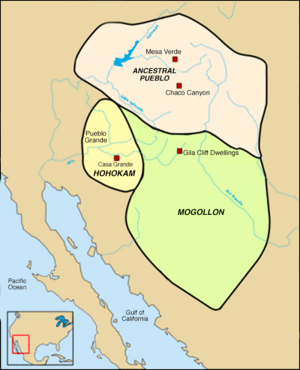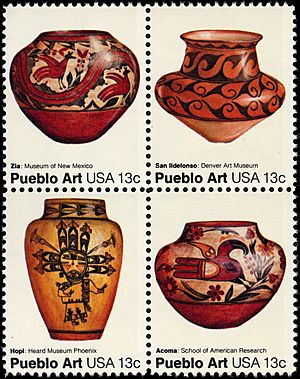Southwestern archaeology facts for kids
Southwestern archaeology is a special part of archaeology that studies the history of people in the Southwestern United States and northern Mexico. This huge area was first home to hunter-gatherers. Thousands of years later, amazing civilizations like the Ancestral Puebloans, the Hohokam, and the Mogollon lived here.
This region includes parts of Colorado, Arizona, New Mexico, Utah, and Nevada in the U.S., and Sonora and Chihuahua in Mexico. People have lived here for at least 12,000 years. It stretches from Durango, Mexico, all the way to Durango, Colorado, and from Las Vegas, Nevada, to Las Vegas, New Mexico. You might also hear this area called the American Southwest or Oasisamerica.
Today, many different groups of people live in the Greater Southwest. These include Yuman-speaking people near the Colorado River, O'odham people in Arizona and Sonora, and Pueblo people in Arizona and New Mexico. The Apache and Navajo peoples, who came from Athabaskan-speaking groups in Alaska and Canada, also arrived in the Southwest before Europeans.
Contents
Ancient Hunters: The Paleo-Indian Era
The first people in the American Southwest were called paleo-Indians. Most archaeologists believe these early people followed large animals like mastodons and bison into North America. These groups were always moving. They hunted big game but also caught smaller game animals, fish, and gathered many different plants.
These Paleo-Indian groups were usually small, maybe 20 to 50 family members. They moved often to find new food sources. They were skilled hunters and made special tools for hunting, butchering animals, and processing hides. The oldest signs of Paleo-Indians in the Southwest are from about 10,000 to 12,000 years ago.
These early people often lived near water, like rivers and swamps, where they could find fish, birds, and game. Large animals like bison, mammoths, and ground sloths also came to these water sources. By 9500 BCE, hunters were in Arizona, where they hunted mule deer, antelope, and other small animals in the desert grasslands.
As the number of large animals decreased, maybe because of too much hunting or climate change, later Paleo-Indian groups started hunting more bison, mule deer, and antelope. They used nets and the atlatl (a spear thrower) to hunt birds, ducks, small animals, and antelope. Hunting was very important in winter and spring when plant foods were hard to find.
From Hunters to Farmers: The Archaic Period
The Archaic period was a big change for people in the Southwest. They began to shift from just hunting and gathering to also growing their own food and settling down, at least for part of the year. This period lasted from about 8,000 years ago to 1,800-2,000 years ago.
During this time, people learned how to use different food sources. They discovered that weed and grass seeds were good to eat. They used flat rocks to grind these seeds into flour to make gruels and breads. This use of grinding stones around 7500 BCE marks the start of the Archaic period. Small groups traveled around, gathering plants like cactus fruits, mesquite beans, acorns, and pine nuts. They set up camps where these foods were plentiful each year.
Later in the Archaic period, corn was brought to the region, probably from central Mexico. People started planting corn near their camps where there was always water. Different types of corn grew in the highlands and deserts, showing how people adapted to their local areas. Other crops they started growing included beans and squash.
Around 3,500 years ago, the climate changed, affecting water sources. This caused the population to drop. However, families found shelter in caves and under rock overhangs in canyons. Sometimes, they lived in small villages in open areas. Many signs of these people have been found in northern parts of the Southwest, from Utah to Colorado, especially near modern Durango, Colorado.
Some of the Archaic cultural traditions include:
- Archaic–Early Basketmaker Era (7000–1500 BCE)
- San Dieguito–Pinto (6500 BCE–200 CE)
- Oshara (5500 BCE–600 CE)
- Cochise (before 5000 BCE–200 CE)
- Chihuahua (6000 BCE–250 CE)
Advanced Civilizations: Post-Archaic Cultures
After the Archaic period, the ancient American Indian cultures in the Southwest developed into three main groups. These cultures, sometimes called Oasisamerica, relied on farming, had organized societies, lived in larger groups, and built impressive structures.
- The Ancestral Pueblo peoples, once known as the Anasazi, lived around the Four Corners area (where Utah, Colorado, Arizona, and New Mexico meet). They started making their unique pottery and building their famous homes around 750 CE. They are known for amazing places like Pueblo Bonito in Chaco Canyon, and also Mesa Verde, Aztec Ruins, and Salmon Ruins.
- The Hohokam culture began around 200 CE. They lived near the Gila and Salt Rivers in Arizona. These people lived in smaller groups but built huge irrigation canals to water their many crops. They traded with ancient cultures far to the south in Mesoamerica (like Mexico), and you can see their influence in Hohokam culture.
- The Mogollon peoples lived in the Southwest from about 200 CE until sometime between 1450 and 1540 CE. Their archaeological sites are found in places like the Gila Wilderness, the Mimbres River Valley, and Paquime.
Besides these three main groups, there were also other cultures in the region:
- The La Junta Indians lived where the Conchos River meets the Rio Grande from 1200 CE onwards. Spanish explorers wrote about them.
- The Patayan culture lived in parts of Arizona, California, and Baja California, including near the Colorado River, between 700 and 1550 CE.
- The Fremont culture lived in Utah and parts of Nevada, Idaho, and Colorado from about 1 CE to 1300 CE.
Understanding Ancient Cultures
Archaeologists use names like Mogollon, Ancestral Pueblo peoples, Patayan, or Hohokam to describe different cultural traditions in the ancient American Southwest. It's important to remember that these names and divisions are made by scientists today, who are far removed from the actual cultures.
This means that these cultural divisions are not always perfect. They are based on the information we have now and can change as new discoveries are made or as scientists' ideas evolve. We can't assume that an archaeological group matches a specific language group or a modern tribe.
When we use these modern archaeological definitions, we need to remember a few things:
- Based on Artifacts: Archaeology studies things left behind by people, like pottery pieces, human remains, stone tools, or old buildings. But other parts of ancient cultures, like their language, beliefs, and daily behaviors, are much harder to know.
- Modern Divisions: These cultural names are tools for today's scientists. They don't mean that ancient people saw themselves as separate groups in the same way. Modern cultures in this region, many of whom are descendants of these ancient people, have a huge variety of lifestyles, languages, and beliefs. This suggests ancient people were also more diverse than their artifacts might show.
- Cultural Differences: Think about how "style" works today. Different groups within a larger culture might do things differently. For example, older and younger generations might dress differently. Some cultural differences might come from traditions passed down through families. Other differences might show social status, gender, or religious beliefs. Sometimes, differences just come from what resources were available in a certain area or time.
It's easy to think of these ancient cultural groups as having clear borders, like modern countries. But this wasn't the case. Ancient people often traded, worshipped, and worked with nearby groups. So, cultural differences usually changed gradually as groups lived further apart. Sometimes, mountains, rivers, or even the Grand Canyon could create big barriers, making it harder for groups to interact. Today, many believe that the Mogollon and Ancestral Pueblo peoples were more similar to each other and more different from the Hohokam and Patayan because of the geography and different climate zones in the American Southwest.



